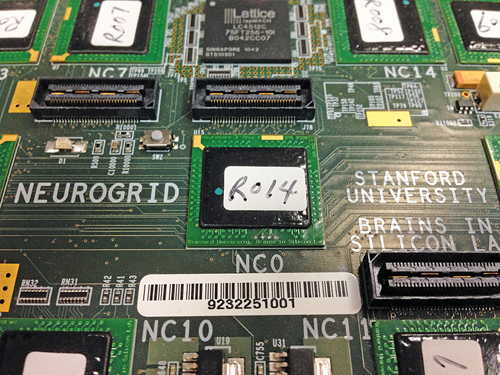Such a highly parallel chip design with configurable electronic neurons helps the team to understand the dependencies, synchronisation and communication among neurons and synapses, so the knowledge can later be applied to computing.
Super chip for prosthetic limbs
A team at Stanford University, headed by Kwabena Boahen, has also developed brain-inspired microchips, details of which were revealed in an IEEE conference earlier this year. The team has used 16 custom-designed ‘Neurocore’ chips to develop a circuit board called the ‘Neurogrid’ that can simulate one million neurons and billions of synaptic connections. The Neurogrid is 9000 times faster than today’s personal computers, and is about 100,000 times more energy-efficient than a PC-based simulation of a million neurons. According to the team’s estimates, a PC consumes 40,000 times more power than a Neurogrid.

Such speed and low-power characteristics of the Neurogrid make it an ideal platform to model and understand the functioning of the brain. Moreover, modified Neurocore chips can also be used for other nature-mimicking functions, such as say, to control prosthetic limbs. This is considered one of the most promising applications of the Neurogrid, and Boahen is working very closely with other teams at Stanford University to achieve this.
Comparing the Neurogrid to other similar projects, such as SyNAPSE and Brain Scales, Boahen writes in his IEEE paper: “Each of these research teams has made different technical choices, such as whether to dedicate each hardware circuit to modelling a single neural element (e.g., a single synapse) or several (e.g., by activating the hardware circuit twice to model the effect of two active synapses). These choices have resulted in different trade-offs in terms of capability and performance.” Boahen arrives at a single metric to calculate the total system cost including the size of the chip, how many neurons it simulates and the power it consumes, and uses it to show the Neurogrid as the most cost-effective way to simulate neurons, in keeping with his goal of creating a system affordable enough to be widely used in research.
However, there are a few areas that the team is seriously working on improving now. One, of course, is the cost. Currently, the development of each Neurogrid uses a 15-year old fabrication process and costs around $40,000. By using modern processes and by fabricating chips in larger volumes, the cost could be brought down to $400 per million-neuron board.
Secondly, the team is also working on creating a neurocompiler to enable people to use the board without knowing anything about synapses and neurons.
The third challenge concerns power consumption. Despite being thousands of times more energy-efficient than today’s PCs, the Neurogrid still lags behind when compared to the human brain. According to Boahen’s paper, the human brain, with 80,000 times more neurons than Neurogrid, consumes only three times as much power. So, arriving at such energy efficiency levels is a huge challenge that faces not just Boahen’s team but the whole global community of neuromorphic engineers.
Spinning the future
Another promising sub-project under the European Union’s Human Brain Project is the University of Manchester’s SpiNNAker—a project that Steve Furber, co-creator of the ARM processor is deeply involved in.
The team has developed a new brain-inspired computer architecture called SpiNNaker, which is being used to develop the SpiNNaker Machine, a parallel computing platform made up of one million ARM processor chips. Each SpiNNaker chip, designed by the team and fabricated in China and Taiwan, features 18 core processors. The machine will feature approximately 56,000 of these super-thin chips, mounted on individual boards carrying 48 units. In a media report, Furber explains that although the SpiNNaker Machine incorporates one million ARM processor cores, the brain is so much more complicated that they will be able to get to just one per cent of the scale of the brain with one million chips.
Last year, the SpiNNaker architecture was put to work on a robot developed by Prof. Jörg Conradt at Technische Universität München. To the robot’s back, the team attached a SpiNNaker board with chips that simulated a neural network to process data from the robot’s eyes or ‘silicon retinas’, in the same way the brain would. The robot was programmed to recognise shapes ‘+’ and ‘x,’ and take a specific action for each. For example, when it spotted a ‘+’ the robot moved forward towards it and when it saw an ‘x’ the robot retreated.
This demo is just the beginning. Over time, the working of, and learning from the SpiNNaker Machine, will be applied to robotics, computer science and neuroscience. It will provide a deeper understanding of the brain’s working, which will hopefully help develop treatments for various mental disorders including Alzheimer’s disease.
Apart from these key projects, there are other global efforts to create neuromorphic chips. There are also numerous efforts to create brain-inspired software that enable conventional processors to imbibe deep-learning capabilities. One good example is the recent deep-learning processing system developed by Purdue University that uses software cum hardware innovations to enable smartphones to quickly grasp and understand their environment by instantaneously overlaying text tags on whatever the camera captures.
Overall, engineers across the world are beginning to understand that the intuitive and úber-powerful computing that the future calls for is possible only by mimicking some or all aspects of the human brain, and are going all out to achieve this.
The author is a technically-qualified freelance writer, editor and hands-on mom based in Chennai






